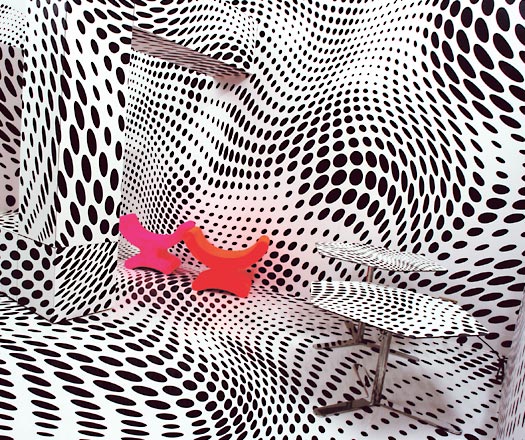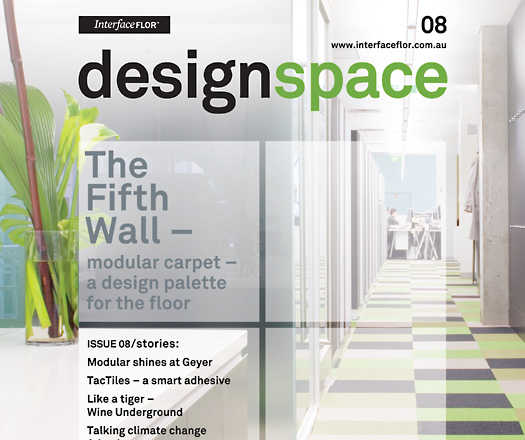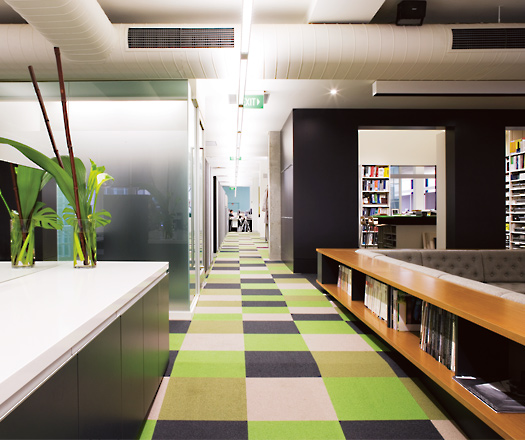Hypnotised by space and the four walls that define it, designers rarely looked down at the floor. But modular flooring has changed all that by creating a fifth wall and the opportunity for a complete design experience.
November 21st, 2008
This article appears in the latest issue of InterfaceFLOR’s designspace magazine. You can get your copy in the October issue of DQ Magazine, Issue #31. Words by Kim Powell. Images – COLORFLAG collection by Markus Benesch.
It’s not so surprising, really, that designers have for so long neglected the floor. We are upright creatures and tend not to look down, but up – at the walls – and see a canvas on which to project emotion through colours and patterns.
Anyway, conventional wall-to-wall carpets traditionally celebrated repetition of patterns – a kind of ready-made experience, a bit like living under socialism where everything was the same for everyone.
Well, if that was socialism, modular flooring is free enterprise where firms are free to create their own environments, where the floor can be customised and where things don’t have to be the same for ever.
Modular flooring is like a new tool box for designers, offering not just a new design palette for the floor but the opportunity for a whole new experience in the work environment.
Carpet tiles were introduced more than 50 years ago, initially to utilise post-industrial waste. At first, they imitated broadloom, but driven by InterfaceFLOR’s spirit of innovation, they began to emerge as a design tool.
The carpet tile offered a totally new experience over broadloom. Instead of a repeated single pattern, flooring could now offer an infinity of experiences and constant stimulation to replace the inevitable monotony of an expanse of uninflected carpet.
But this implied an even more revolutionary possibility. Since traditional carpet was repetitive, it followed that spaces had to be defined by the walls, by furnishings or room dividers. The carpet tile, however, gives designers the flexibility to define spaces using a mix of tiles – making the floor the fifth wall.
To read the rest of this and other great articles get your copy of designspace inside Issue #31 of DQ magazine, out October 2.



INDESIGN is on instagram
Follow @indesignlive
A searchable and comprehensive guide for specifying leading products and their suppliers
Keep up to date with the latest and greatest from our industry BFF's!

The Sub-Zero and Wolf Kitchen Design Contest is officially open. And the long-running competition offers Australian architects, designers and builders the chance to gain global recognition for the most technically resolved, performance-led kitchen projects.

Schneider Electric’s new range are making bulky outlets a thing of the past with the new UNICA X collection.

BLANCOCULINA-S II Sensor promotes water efficiency and reduces waste, representing a leap forward in faucet technology.

In this candid interview, the culinary mastermind behind Singapore’s Nouri and Appetite talks about food as an act of human connection that transcends borders and accolades, the crucial role of technology in preserving its unifying power, and finding a kindred spirit in Gaggenau’s reverence for tradition and relentless pursuit of innovation.

The American Hardwood Export Council and Tom Fereday recently launched External Review – a reflection of the Cove Lounge’s design process, from start to finish.
Project Team: Stephen Minnett, Vanessa Craig, Maggie McFadyen Square Metres: 1600 over 2 levels Location: Camperdown, NSW Completed: Jul 2009 “Futurespace worked very closely with Buildcorp on the upgrade and refurbishment of their own building in Camperdown, Sydney. The work carried out was part of a staged refurbishment of Buildcorp’s building and also included new […]
In following the idea of less is more the Gimminy range of tables are elegant in form and highly functional. You really can’t get more simple than four legs and a top, but oh what a difference when the design is intelligently thought through and beautifully made! Gimminy is used in residential and commercial interiors […]
The internet never sleeps! Here's the stuff you might have missed

This new book tells resident stories about how good design creates liveable, high-density homes with socially led developer Neometro.

Hayley Mitchell and Samantha Eades are creating some of today’s best restaurants, most exciting cafés and bars, and extraordinary hotels and resorts.